Bausch + Lomb Cis: From Zero to Hundreds of Thousands of Customers in the Database Thanks to the CDP and Loyalty Program
Bausch + Lomb Cis: From Zero to Hundreds of Thousands of Customers in the Database Thanks to the CDP and Loyalty Program
Challenges
Build direct communications with customers from scratch to increase the market share
Solutions
Implement marketing automation, a customer data platform and loyalty program
Results
Hundreds of thousands of customers have been added to the database over the past 2 years
50% of these customers were obtained via online marketing during the first 9 months of the contact lens fitting campaign
Tens of thousands of loyalty program members with verified data were collected over the first campaign year
10 million bonus points were given out during the first year of the loyalty program
50% of these customers were obtained via online marketing during the first 9 months of the contact lens fitting campaign
Tens of thousands of loyalty program members with verified data were collected over the first campaign year
10 million bonus points were given out during the first year of the loyalty program
Integrated with:
Website
A customized personal customer account
Mindbox marketing automation platform
A customized personal customer account
Mindbox marketing automation platform
Noteworthy features
Interactive AMP and surveys
Contact lens manufacturer Bausch + Lomb has been building direct marketing communications with its customers from the ground up since 2018. During this time, Bausch + Lomb managed not only to create a loyal customer base, but also to test different formats of promotions and methods of communication. These include promo codes given out during registration on the website, in text messages or printed on packages. In this story, we will be looking at:
- How the pharmaceutical company’s branch transformed into FMCG with several promotion channels.
- How the loyalty program was created.
- How Bausch + Lomb chose the platform.
CDP and loyalty program implementation results
-
Hundreds of thousands of customers were collected in the database over 2 years -
Tens of thousands of loyalty program members with verified data over one campaign year were collected -
50
% of customers were obtained via online marketing during the first 9 months of the contact lens fitting campaign -
10
million bonus points were awarded during the first year of the loyalty program
The project is expanding exactly how we expected. We are very excited about the loyalty program. It’s a logical completion of the sales funnel that we started building in 2018, which includes the creation of digital media assets, the main customer website, and other resources as well as the launch of our trial campaign.
We believe this is the most balanced loyalty program within the eye care market in terms of benefits for its members. I would also like to mention the in-depth involvement of Mindbox in these projects. I really hope we will further our collaboration as we are counting heavily on this strategic program.
Why Bausch + Lomb decided to implement a CDP and loyalty program
Previously, Bausch + Lomb did not collect customer data, nor did it communicate with its customers directly.
So in order to create a customer base, carry out promotions and analyze customer behavior, the brand decided to consolidate all solutions into one, single marketing platform. At the time, the company didn’t have the suitable infrastructure to comply with personal data legislation requirements. For this reason, the team chose a third-party solution that would store data and support marketing activities.
Our main task was to create a customer marketing model from scratch. We took bids from agencies for website development and for digital campaign implementation, which included a CRM block. We approached this goal from two perspectives. Our first strategic task was to build a foundation to attract new consumers.
Our two main competitors had already developed concepts of this as part of their optician selection program. At the time, one of them was already generating additional traffic from digital source channels.
The second strategic initiative was an expansion of the loyalty program. From the very beginning we planned that it would include a bonus points program, gamification, scoring, and various other features to continue building our customer funnel.
Which criteria were used to select the CDP and loyalty program
Requirements for the marketing platform
Mindbox functionality
Compliance with customer personal data legislation
Personal data is stored on secure servers
Being able to use emails, text messaging, pop-ups and exchanging information with these sources
Emails, texts and pop-ups are created and sent/launched right inside the platform
Being able to use different marketing instruments, including the launch of promotions, customer segmentation, and the creation of trigger chains
Marketing promotions with built-in Promotion Priority Management
Customer segmentation based on purchase history, online behavior and personal data
Cross-channel trigger and transactional messages with hundreds of different scenario flows
A multifaceted loyalty program with bonus points, gamification, and interactivity
Individual and bulk discounts and promotional codes, interactive emails with puzzles, customer account maintenance, AMP surveys
A customer success manager who coordinates the project
A Mindbox customer success manager accompanies the project at every stage, from integration to the launch of specific campaigns and features, as well as their development
Transparent pricing
A cost calculator that allows clients to find out the cost of the platform based on their needs — depending on the number of customers in their database and desired modules
Mindbox is a flexible and multi-functional platform with excellent customer service. New users may find the interface a bit complicated, especially if there are a lot of integrations, campaigns, features and segments in one project, like ours.
It would be great to add the ability to build dashboards instead of creating them using a third-party system.
There are also not enough representative offices in CIS countries like Ukraine, Belarus, Kazakhstan, etc. This is a problem area for managers overseeing these regions.
As of now, I think it is difficult to work with Mindbox in-house. I mean, if we didn’t have a customer support service or, rather, a specifically assigned manager, then we wouldn’t be able to get anything up and running.
This leaves us very vulnerable as clients. On the other hand, if Mindbox is accumulating expertise internally, it means that even if the company changes employees, the previous employee’s expertise will not be lost, but shared among other Mindbox employees.
Our system is flexible and works with a variety of businesses. However, it is hard to create a tool that’s 100% suitable for everyone.
Most customers use Mindbox for repeat sales and to grow their revenue. In the case of Bausch + Lomb, we worked with proxy metrics, which applies to people, promo codes, and surveys. Creating dashboards for these types of metrics in the platform is not really possible. However, we were able to upload raw data in a suitable format, which allowed our colleagues to generate their own reports.
It can quickly become tedious to work with the system in-house on your own. For example, it can become quite challenging for managers who lead several projects and are expected to work with the system manually. To make things easier, each of our clients gets a personal customer success manager, who is devoted to the project at every stage of its development. Mindbox also has a Help Center that contains the answer to pretty much any question and provides a lot detailed info on how to use the platform.
How promotions were segmented using multiple websites
Bausch + Lomb studied their audience and formulated a hypothesis. The assumption was that it would be more effective to create separate promotional websites for different customer segments. This outcome would depend on customers’ personal details or behavior towards specific promotions.
In accordance with this hypothesis, the company created two lead-generating websites. The first operated as the main website, while the second aimed to generate customer traffic and serve as an omnichannel landing page. The text and the website’s main page changed depending on the audience segment accessing this landing page. In addition, Bausch + Lomb uses lead generation forms on social networks. The company plans on further developing its approach to segmentation.
How the loyalty program and promotions work
We’ve identified two lines of communication with customers — campaigns for new customers and campaigns for existing customers. New customers are attracted by promo codes, which are obtained once they fill out a lead form on the website. Current customers receive feedback surveys via AMP emails and text messages to assess their satisfaction.
To attract new consumers, we offer a free lens selection as well as a free first pair of contact lenses after a customer has their eyesight checked by an optician. To take advantage of the offer, customers need to fill out the lead form and present the optician with a unique code received via email. This offer is valid throughout the CIS.
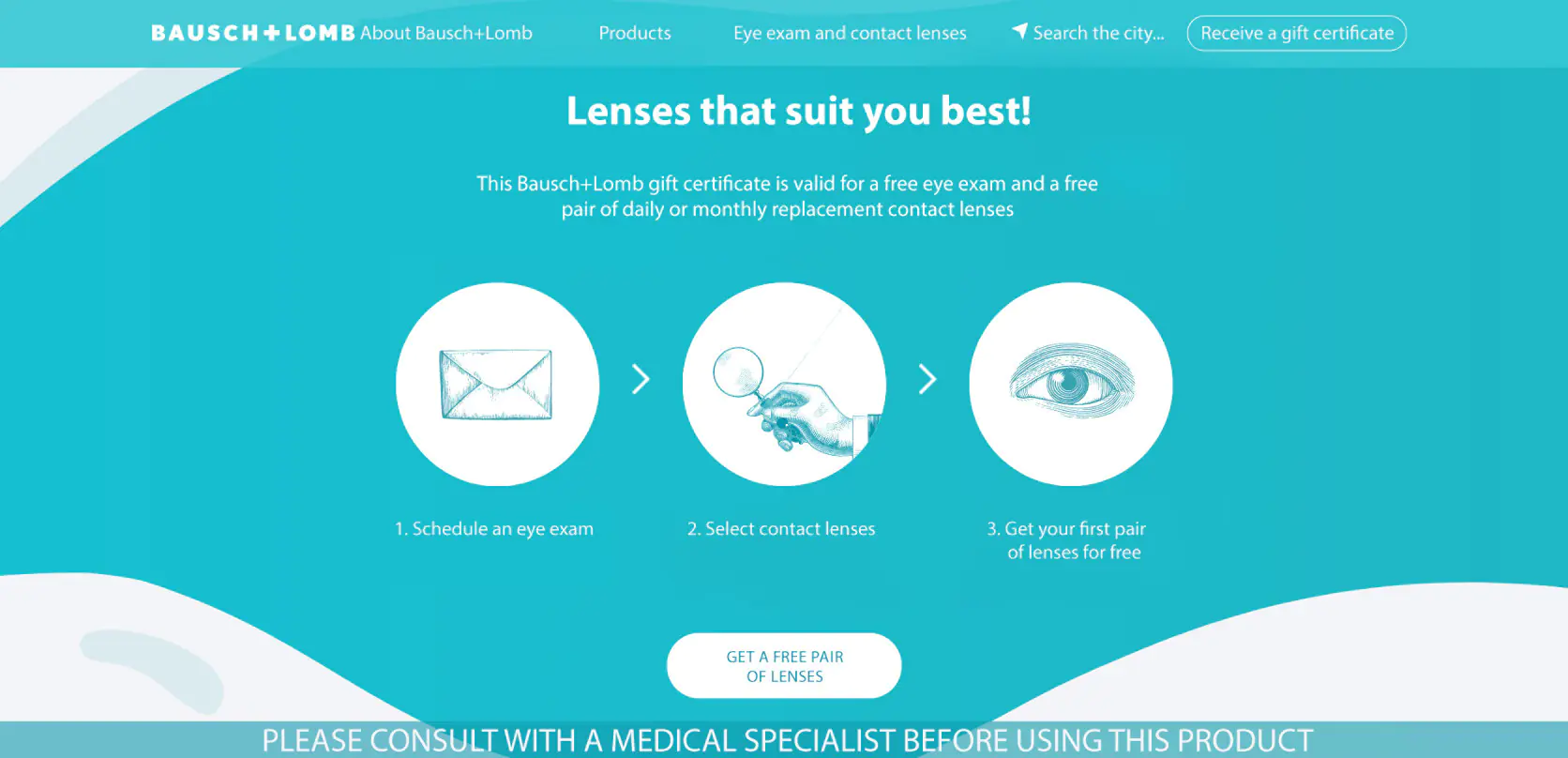
Free selection of a pair of lenses for filling out the lead form on the website
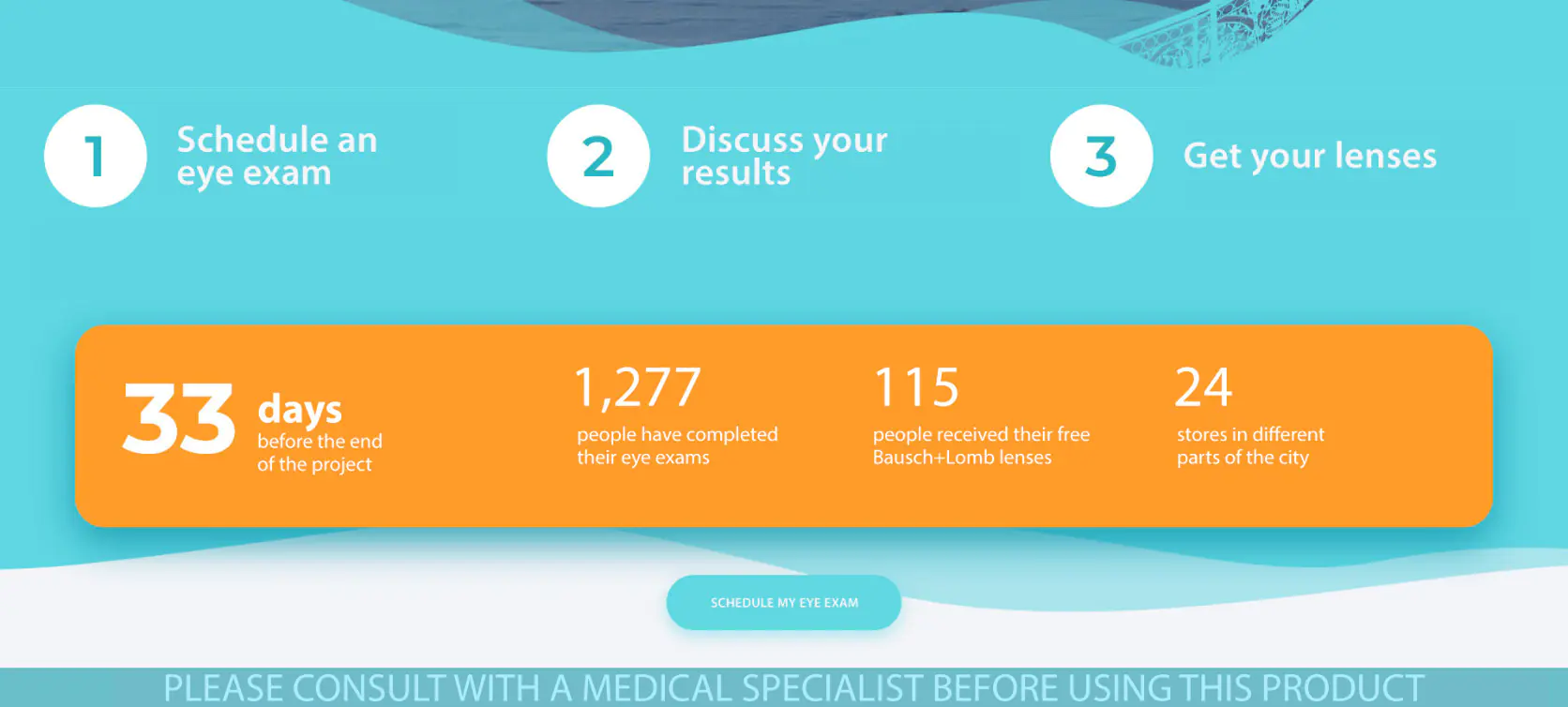
The “Art of Seeing” social project offers free eye exams as well as a free first pair of contact lenses, if needed.
After filling out the lead form, the customer’s data gets sent to Mindbox’s system. Promo codes are then generated and validated there, while an automatic reminder chain is simultaneously launched.
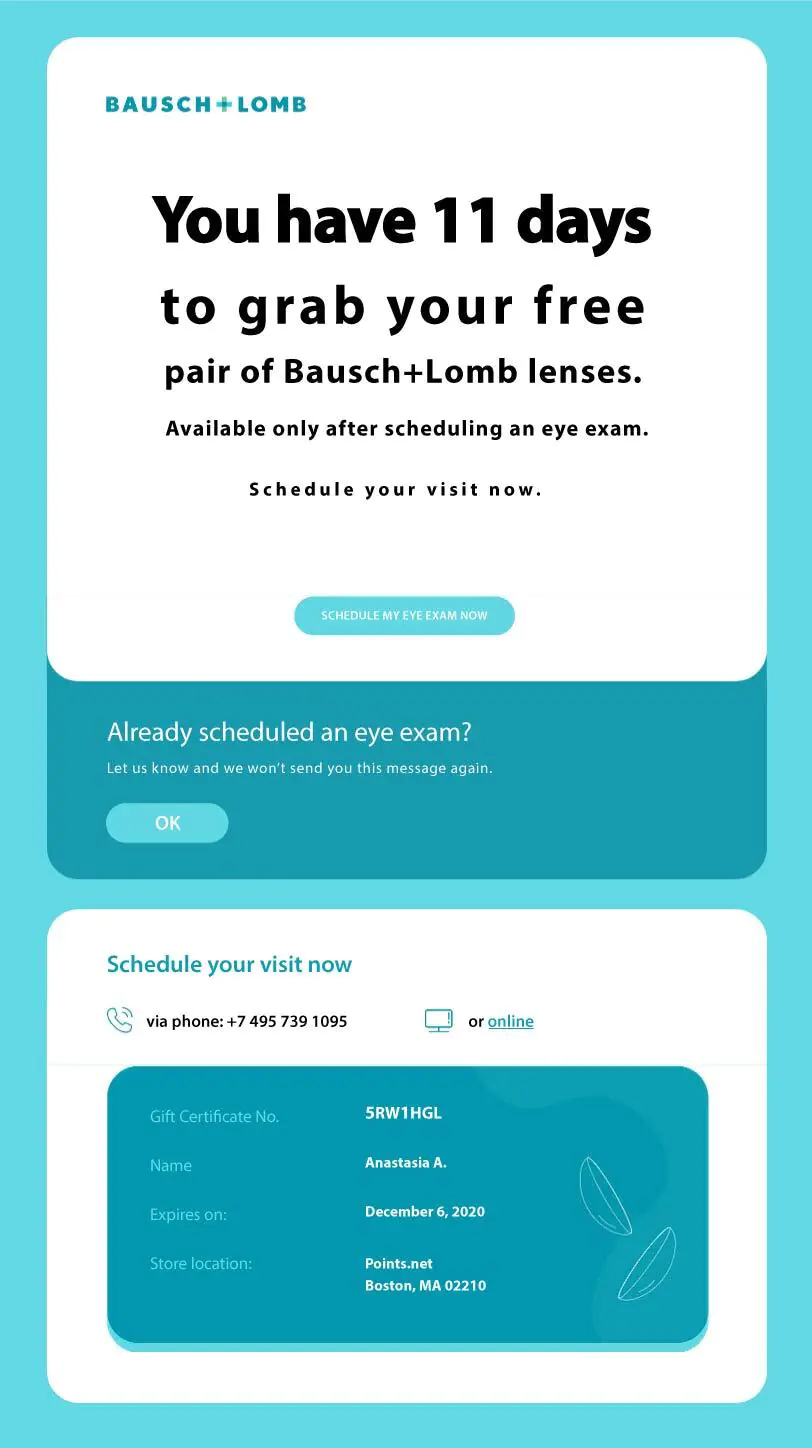
Automated reminders about the promo code’s expiration date. The vision specifications that the customer entered during registration are restated in the email
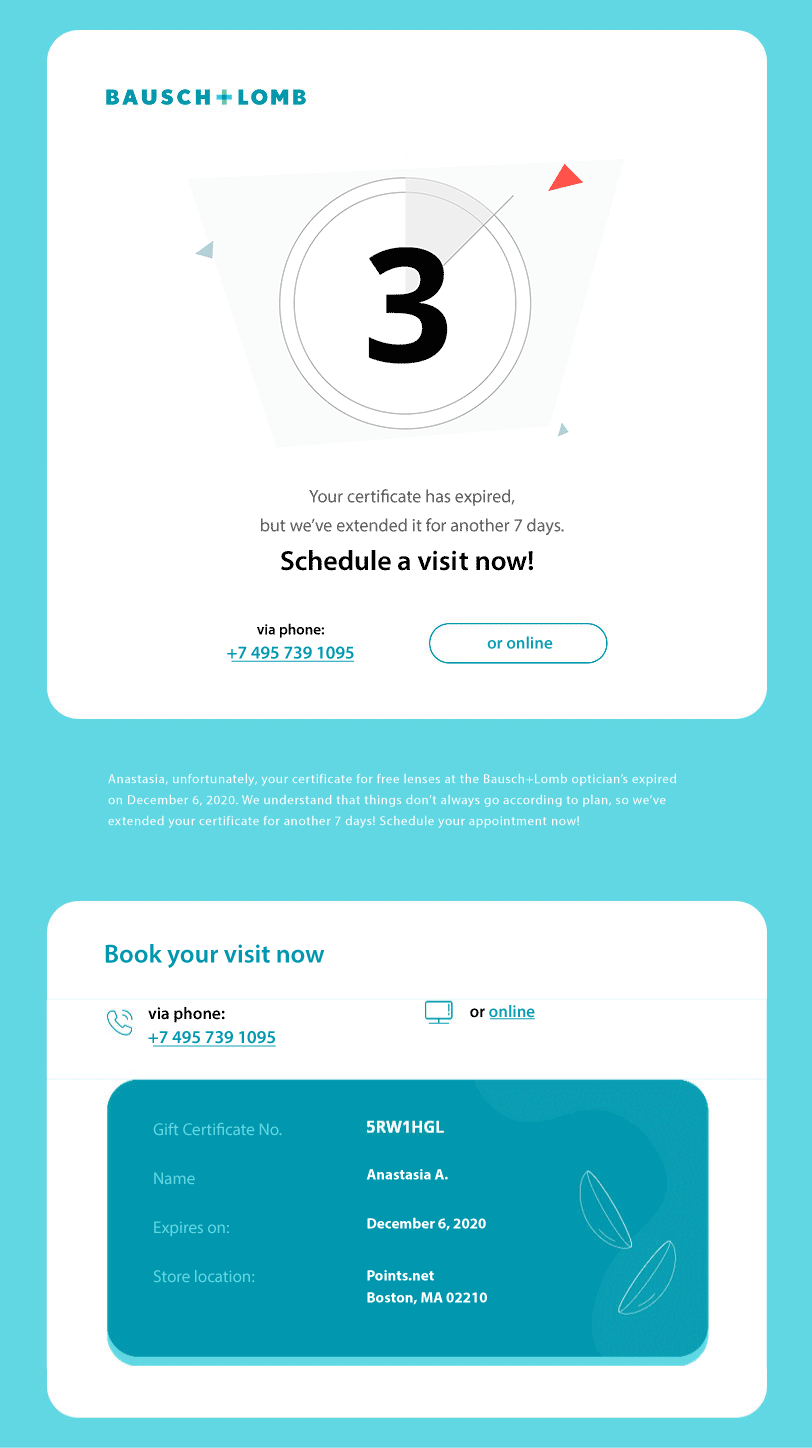
If the promo code has expired, it is renewed for a week. The customer is then encouraged to make an appointment for an eye exam before the week’s end
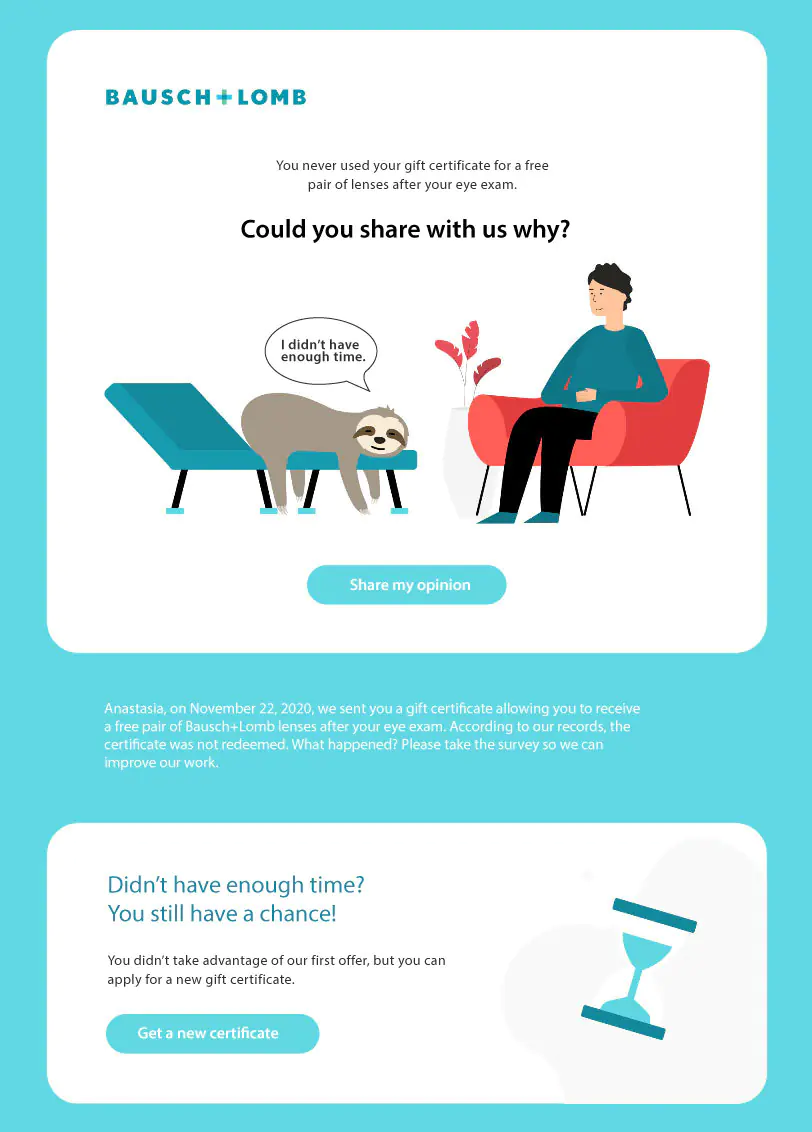
If the customer did not use the promo code, we try to find out why and offer them the chance to get a new promo code
When a customer uses their promo code at an optician’s, the optometrist checks the promo code number using a special interface, and then makes a note that it has been redeemed. This information is then automatically transfered to Mindbox. The process is similar to when a customer uses a discount code at a POS as part of a loyalty program.
The promo code is delivered via text message
The customer has the option to take part in the free selection and free first pair of lenses campaign on the website or via text message. The offer is advertised in participating stores so that a customer can receive their promo code right away.
To receive their code, a customer simply needs to text the code word “Lens” to a short promotional phone number — 5115. Sending messages to this number is free. The Rapporto text messaging agency assigned the short number and created a gateway to exchange text message information with Mindbox. The system checks if the customer is new, saves the cell number, and issues a promo code. The rest of the processes are the same as for the landing page.
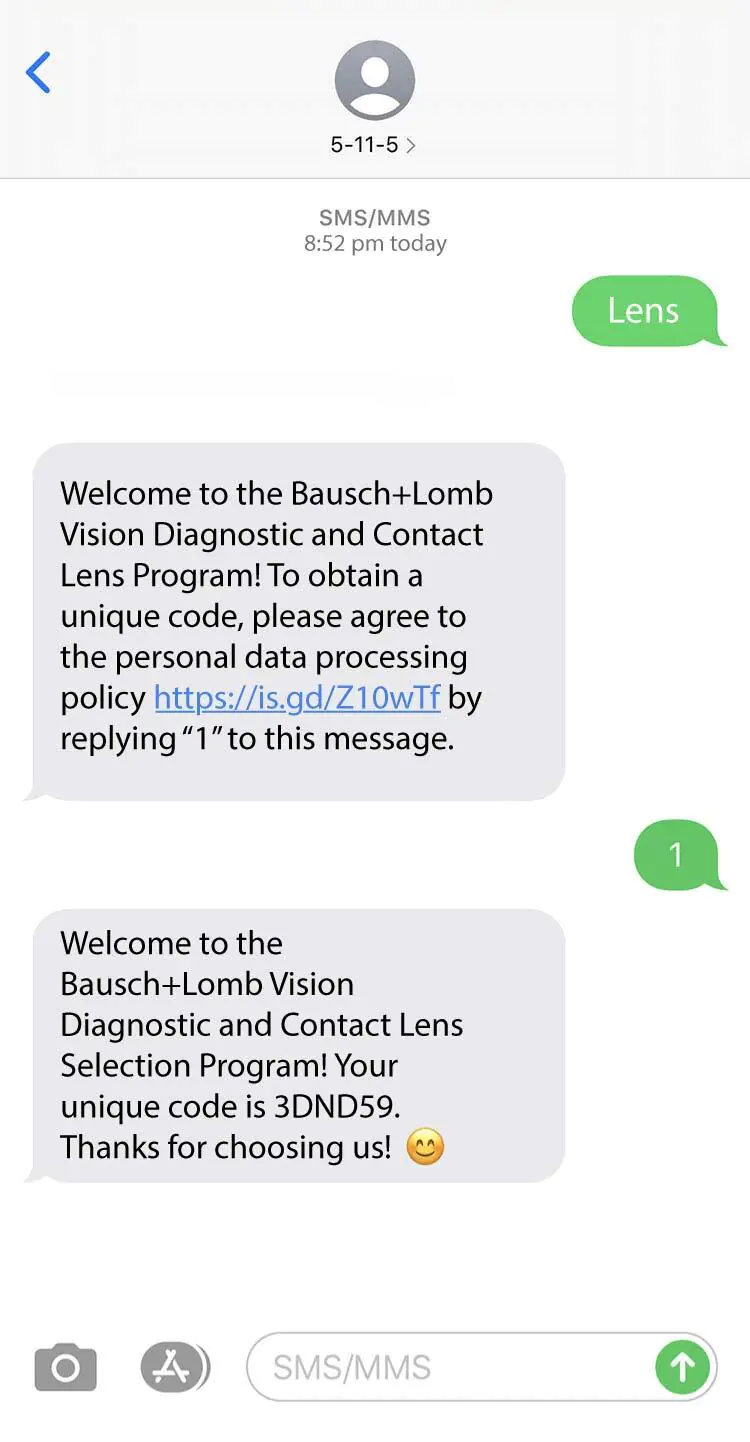
Verification and promo codes are issued via texts to a short number
When the marketing automation platform receives confirmation that the promo code has been redeemed, the customer is then asked to take part in a survey. This is how Bausch + Lomb find out how opitican stores work, what services are actually provided, and how satisfied customers are.
An AMP survey is sent to the customer’s email, where customers give their responses within the email itself, without needing to visit the website. Should the customer’s inbox not support AMP surveys, the email will also contain a link to a special survey page. In either case, Mindbox receives all customer responses.
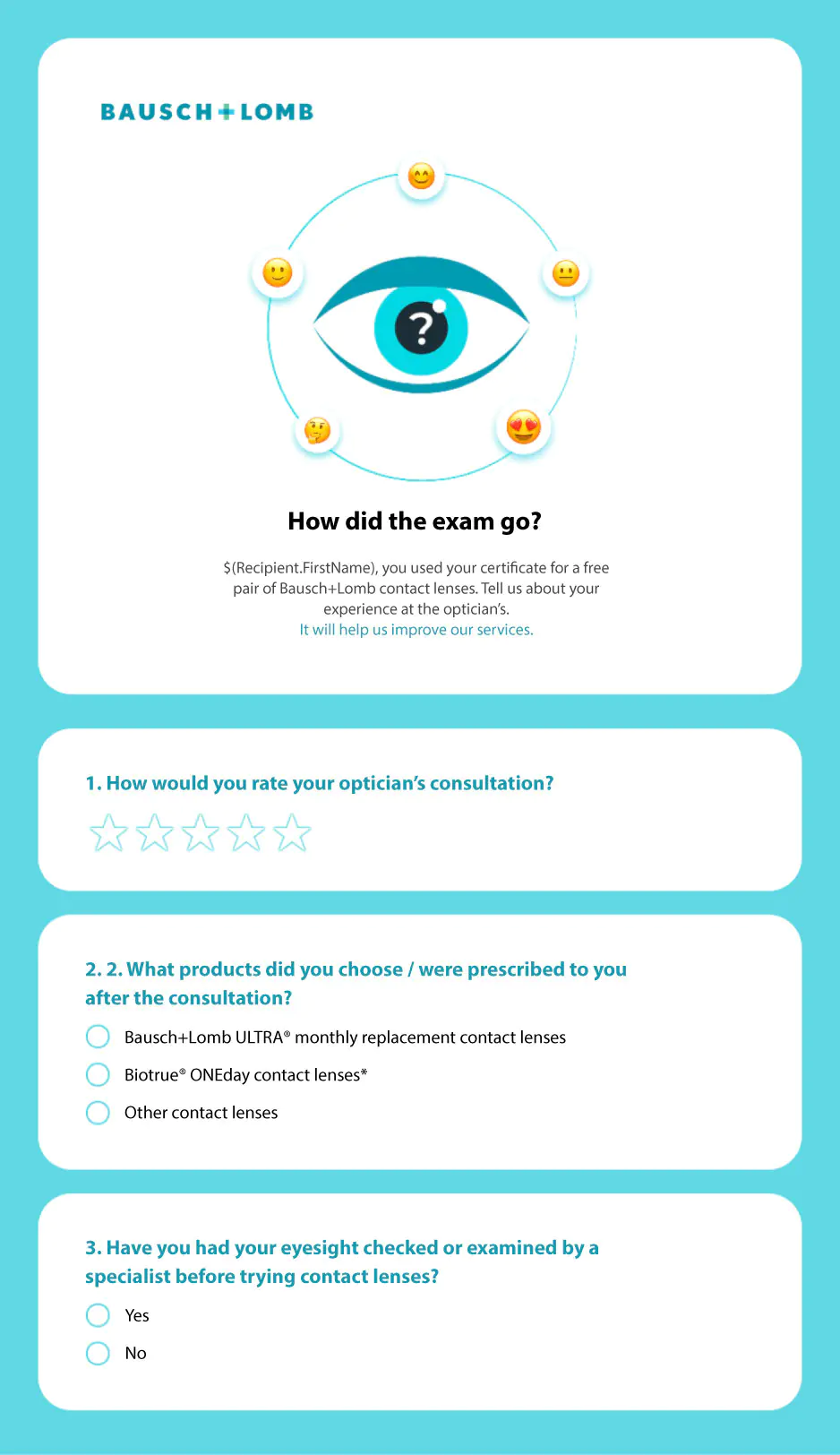
AMP survey with a built-in data entry form
Surveys are also sent via text message.
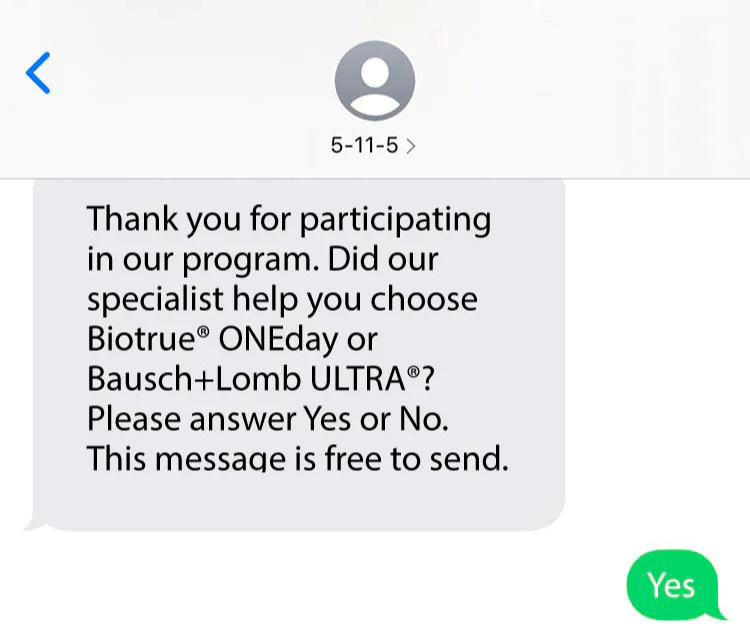
SMS surveys are sent after a customer visited an optician. Each question offers different types of answers — “+” or “-”, “yes” or “no” — to properly distribute answers on the platform.
Bonus points and promo codes on product packages
To boost the loyalty of our existing customers, we launched a bonus point system. Bonus points are awarded when signing up for the loyalty program, for recommending friends, for providing reviews and taking surveys, for birthdays, and for purchases. Bonus points can be spent in the rewards section on the website. For instance, a customer can receive a promo code for a discount at an optician’s or in the online store. Other discount promo codes can be used for an online consultation with an ophthalmologist, a streaming service subscription, e-books, lens packages or a webinar.

Terms of the loyalty program can also be seen here. The whole system is based on bonus points.
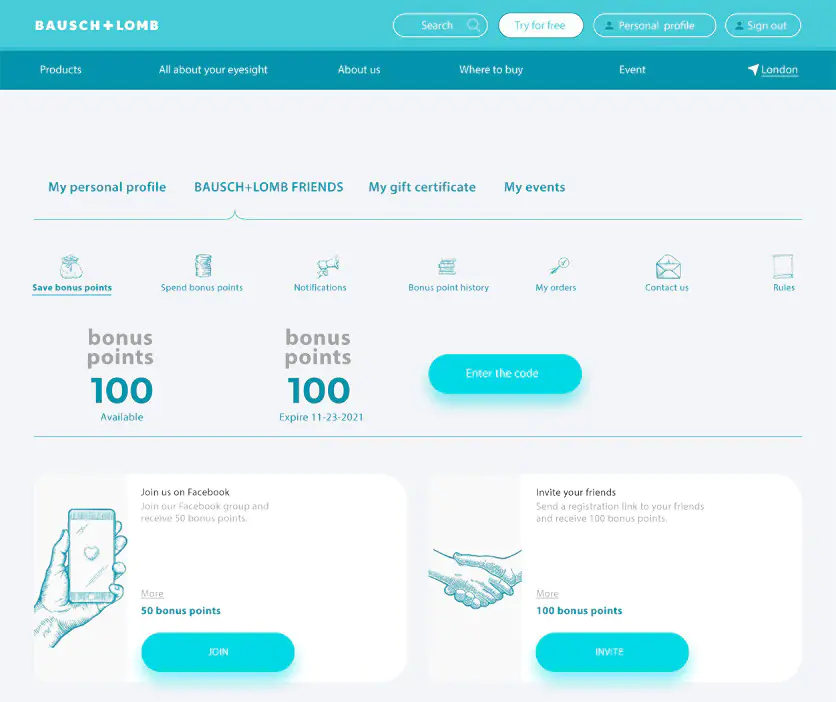
The customer profile page contains information about how many bonus points the member has, how many more can be earned, and how to earn more.
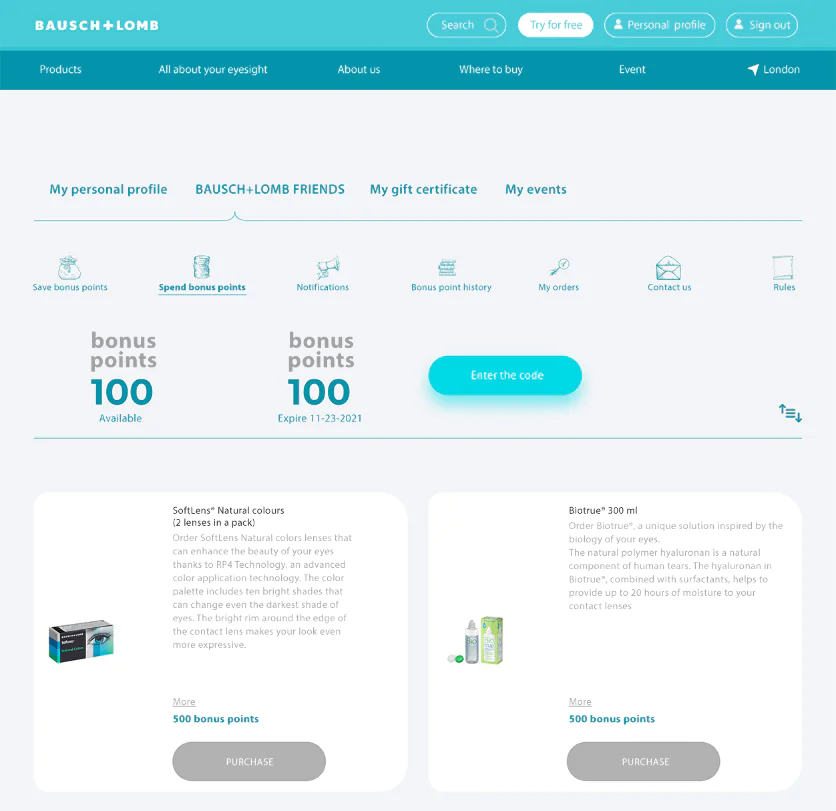
A rewards section allowing the customer to receive free contact lenses, a lens solution or a promo code for products and services from partnered companies in exchange for bonus points is also present
In order to award bonus points for purchases made online and in our partners' stores, we created a financial model calculating how many bonus points can be given out for particular products. We also generated promo codes and attached them to products via the marketing automation platform. After registering a promo code in the customer profile area, the member receives bonus points.
Webinars and memos
In order to maintain customer engagement, build brand credibility, and attract new contacts, Bausch + Lomb hosts webinars about vision and sends out useful emails on eye care and products. This information is also available in specific tabs on the website and on pop-ups if a customer spends enough time on the website.
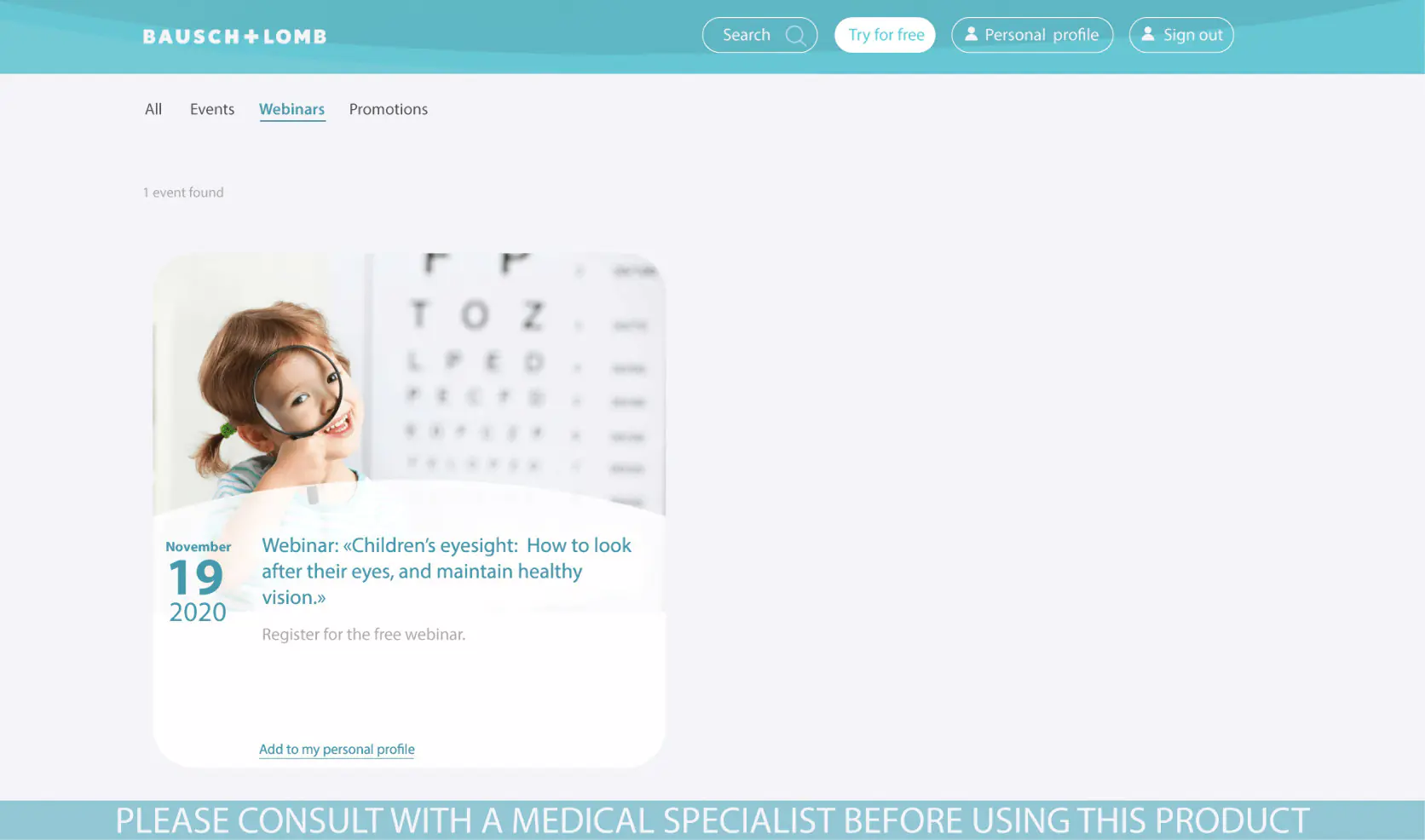
Webinars about vision first took place in the fall of 2020. All information regarding webinar registrations and upcoming webinar reminders are stored in Mindbox. Viewing webinars offers customers the chance to receive loyalty program bonus points
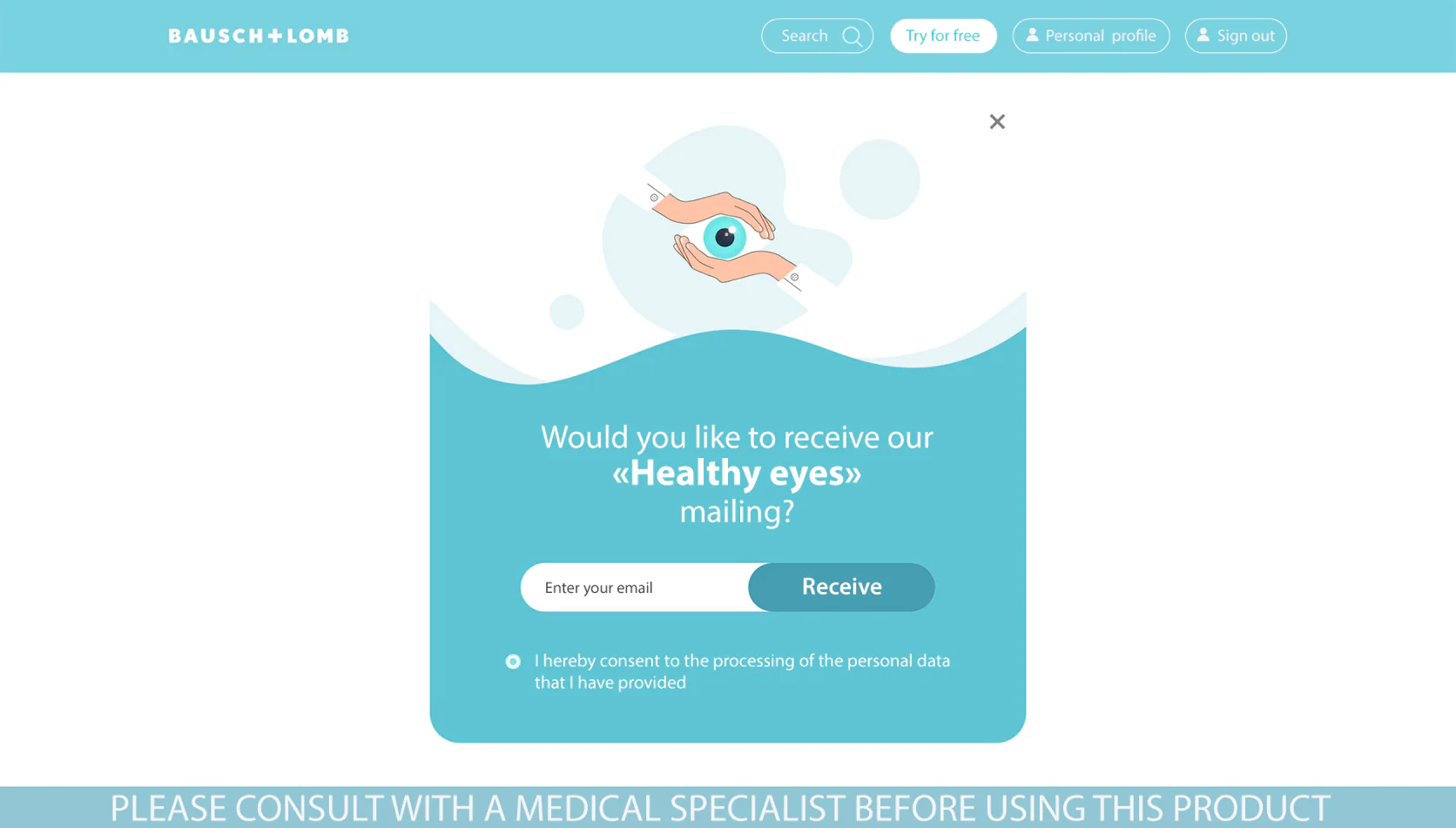
After a few minutes of browsing the website, a pop-up appears inviting the customer to enter their email and receive a memo on eye health
Plans on developing communications and the loyalty program:
- Expand the pool of partners and launch more affiliate programs.
- Develop a more comprehensive cross-category loyalty program with personalized offers for customers. For example, discounts on products in exchange for bonus points with Bausch + Lomb and their affiliates have already been implemented.
- Release a mobile app. This is also already in the works.
Daria Vasilyeva, Bausch + Lomb Digital Marketing Manager, shares tips on how to start building cross-channel tailored communication with customers
- Start small: determine what data you need to collect and how you will use it.
- Try email communication. This is the simplest and the most basic approach. Emails help you test different hypotheses and get acquainted with your database. This approach is suitable for both B2B and B2C segments. In addition, email marketing capabilities are developing, and now it is possible to launch interactive mailings. If you don’t use a CRM-system, it is then necessary to ensure that the marketing platform safely stores the data, and allows you to tackle bulk and specialized marketing mailings.
- Develop your first content plan and launch it. Then analyze the audience’s response and make the necessary adjustments.
P. S. In this article we mentioned the following Mindbox modules: Customer Data Platform (CDP), Loyalty program, Omnichannel communications and Website personalization. Learn more about these products on the pages linked or by reaching out to us.




